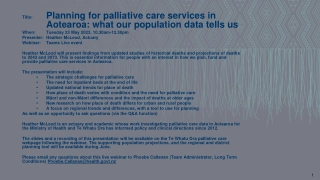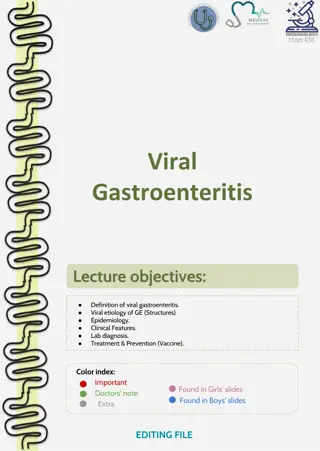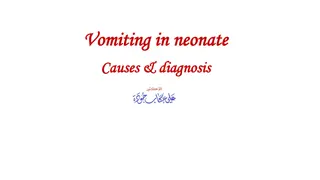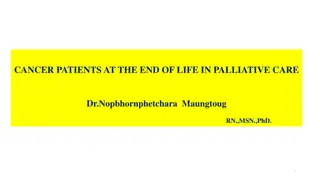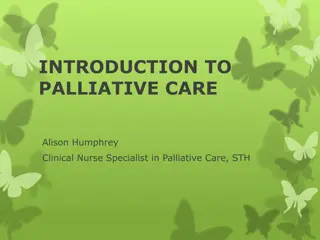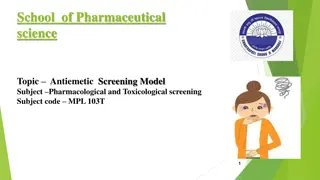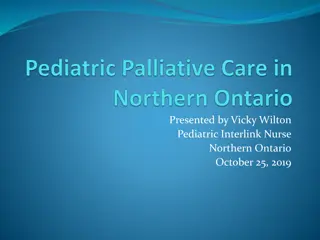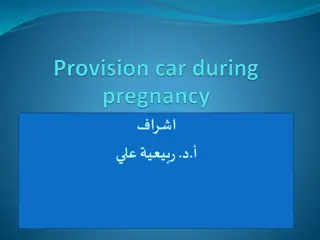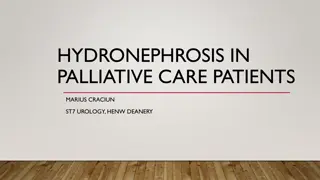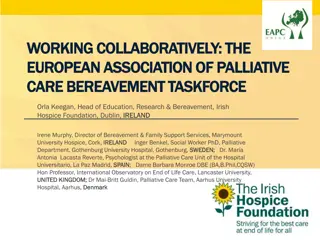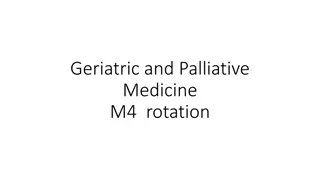Nausea and Vomiting in Palliative Care
Nausea and vomiting are common symptoms in patients with advanced cancer. This article discusses the definitions, importance, and pathophysiology of these symptoms, shedding light on their prevalence, associated conditions, and neurological processes involved in the vomiting reflex.
Download Presentation

Please find below an Image/Link to download the presentation.
The content on the website is provided AS IS for your information and personal use only. It may not be sold, licensed, or shared on other websites without obtaining consent from the author. Download presentation by click this link. If you encounter any issues during the download, it is possible that the publisher has removed the file from their server.
E N D
Presentation Transcript
Nausea & Vomiting Dr. Lucy Harris SpR Palliative Medicine September 2014
A Starting Point - Definitions Nausea: An unpleasant sensation of the need to vomit, often accompanied by autonomic symptoms sweating, salivation, tachycardia. Vomiting: Forceful expulsion of gastric contents through the mouth, caused by forceful and sustained contraction of the abdominal muscles and diaphragm. Anticipatory vomiting: Vomiting in the absence, but caused by anticipation, of the stimulus e.g. chemotherapy Retching: Rhythmic, laboured, spasmodic movements of the diaphragm and abdominal muscles against a closed glottis
Its all in the history. Regurgitation The movement of contents of the stomach into the oesophagus and / or from the oesophagus into the mouth. Rumination The controlled, voluntary regurgitation of undigested food from the stomach into the mouth (food often then swallowed again). Often associated with psychiatric disorders Oesophageal secretions - Frothy, stringy white or colourless secretions, associated with oesophageal cancer. May respond to steroids.
Why Is It Important? About 60 % of patients with advanced cancer will experience nausea and / or vomiting at some point Prevalence of about 40% in the last six weeks of life More common in: Stomach / Breast Cancers Women Patients under 65 Least common in: Lung Cancer Arch Intern Med. 1986;146(10):2021-2023.
Pathophysiology Emetic process not fully understood Awareness of physiology of vomiting and main neurotransmitters involved can help in assessment and choice of appropriate anti- emetic
Cortex CTZ GI VOMITING CENTRE (Medulla) Vestibular VOMITING REFLEX
Receptor Sites Cortical Structures (eg. anxiety, sights, smells, raised ICP): GABA Histamine (H1) Serotonin (5HT2) Vomiting Centre: Muscarinic(Ach) Dopamine (D2) Chemoreceptor Trigger Zone: Serotonin(5HT3) Histamine (H1) Vestibular Apparatus: Muscarinic(Ach) Serotonin(5HT3) Serotonin (5HT4) Gut Mucosa: Dopamine (D2)
The Vomiting Reflex Involves multiple structures - the pharynx, larynx, upper GI tract, the muscles of the thorax, abdomen and diaphragm and the respiratory and salivatory centres. It causes ; 1) Nausea, with autonomic symptoms 2) Gastric stasis / atony (relaxation of smooth muscle wall of stomach) 3) Retching with closure of vocal cords 4) Elevation of palate (to close nasopharynx) 5) Reverse peristalsis 6) Contraction of the abdominal wall and chest muscles
Consideration of Causes in the Palliative Setting Case Example 1: 75 man, CA lung with bone metastases lower back. Started regular oromorph for back pain Complaining predominantly of nausea. Case Example 2: 60 women, CA breast with liver, bone and brain metastases. On morphine for several weeks. Not constipated. Complaining of N&V. Vomiting does not relieve nausea.
Management Approach. ESTABLISH THE CAUSE Urine Dip, U&Es, Calcium, Relevant Drug Levels, ?AXR, Brain imaging Investigations Hydration, Temperature, Mouth, Abdomen, Rectum, Fundi, Neurology Examination Onset, Timing, N vs V, Triggers, Associated factors, Content of Vomitus, Drugs History
Principles of Treatment 1: Treat the cause 2: Non-pharmacological approaches 3: Anti-emetics The most common mistakes in treating nausea & vomiting are: not considering reversible factors using oral route for anti-emetics in established nausea & vomiting
Non-Pharmacological Approaches Control Malodour (eg: fungating tumours) Consider environment - away from sight and smell of food. Ask others to take on role of food preparation Meal Size - Small snacks regularly Complementary Therapy eg: acupressure bands / Acupuncture Distraction
Approach to Anti-emetics: Anticipate Regular doses and consider most appropriate route of delivery Target the relevant receptors according to cause Consider Combination
Receptors in Vomiting Pathways Stimulus Area Receptors D2 5HT3 Drugs, Metabolic Chemoreceptor trigger zone Muscarinic (Ach) Histamine Motion, Position Vestibular D2 5HT3 Cannabinoid Visceral Organs ? Non- specific CNS Histamine ICP Cerebral cortex Mike Harlos, Manitoba
Antiemetics site of action CTZ Haloperidol Metoclopramide Domperidone Levomepromazine Ondansetron Granisetron VOMITING CENTRE Vestibular Hyoscine hydrobromide Cyclizine Prochlorperazine Levomepromazine Hyoscine hydrobromide Cyclizine Prochlorperazine Levomepromazine GI Metoclopramide Domperidone Ondansetron Granisetron Mike Harlos, Manitoba
Management Pharmacological
Other drugs used to manage nausea and vomiting Dexamethasone Decreases permeability at CTZ, inhibits central PG synth Ranitidine Decreases volume of gastric secretions Octreotide Decreases GI secretions (useful for large volume vomits in malignant bowel obstruction) PPI Decreases acidity Antifungals Treat oropharyngeal candida Benzodiazepines For anxiety, ??GABA effect
Antiemetic Ladder STEP 2 2nd line narrow spectrum eg ondansetron OR combination eg cyclizine+haloperidol OR broad spectrum eg levomepromazine See full size image STEP 1 Narrow spectrum Metoclopramide Cyclizine Haloperidol
Route is important Essential to consider antiemetic route if already vomiting / absorption concerns Transdermal: Scopaderm TTS releases 0.5m hyoscine hydrobromide / 72 hrs Buccal: Buccastem (Prochlorperazine tab absorbed from buccal mucosa) 3mg/12hrs Rectal: Prochlorperazine (25mg tds) Domperidone (30-60mg qds) S/C: Cyclizine (100-150mg/24hrs) does not combine well in csci Haloperidol (2.5-10mg/24hrs) Levomepromazine (6.25-100mg/24hrs) (2:1 conversion for po : sc) Metoclopramide (30-120mg/24hrs) Octreotide (100-1200mcg/24hrs)
Additional Hints If using more than one anti-emetic, use those that act on different receptors 30% pts require 2 anti-emetics If previously on regular antiemetics add to these to a syringe driver if started for other reasons Avoid dopamine antagonists (esp; metoclopramide, haloperidol) in PD Reassess regularly!
Summary N+V are common in end-stage disease, and significantly affect QOL. Determining and reversing cause(s) if possible is paramount, often multi-factorial Usually easily treated, many anti-emetics choice depends on cause. Use regular antiemetics, by appropriate route, with PRN provision Oral medication rarely works if established vomiting or severe nausea.
Cause of Vomiting 1st Line Antiemetic Dose 2nd Line Antiemetic Dose Drugs / Toxins Haloperidol 1.5-3mg nocte/bd Levomepromazine 6.25 -25mg / 24 hrs Radiotherapy Ondansetron 8mg stat, then bd for 5/7 Haloperidol 1.5-3mg nocte/bd Chemotherapy Ondansetron 8mg stat, then bd for 5/7 Metoclopramide 20mg tds/qds Dexamethasone 4-8mg od Metabolic (eg. Ca/Uraemia) Haloperidol 1.5mg nocte/bd Levomepromazine Cyclizine 6.25-25mg / 24 hrs 50mg tds Raised ICP Cyclizine + Dexamethasone 50mg tds 8-16mg / 24hrs Levomepromazine + Dexamethasone 6.25-25mg / 24hrs 8-16mg / 24hrs Bowel Obstruction (with colic) Cyclizine +/- Buscopan +/- Octreotide +/- Dexamethasone 150mg / 24hrs 40-100mg /24hrs s/c Haloperidol Levomepromazine +/- Buscopan / Octreotide / Dexamethasone 1.5-3mg od/bd 6.25-25mg / 24hrs 300-1000mcg/24hrs s/c 8-16mg / 24hrs Delayed Gastric Emptying Metoclopramide 10-20mg tds/qds Domperidone 10-20mg qds Gastric Irritation PPI for gastritis Stop irritants- NSAIDs Cyclizine Ondansetron Metoclopramide Levomepromazine 8mg bd 10-20mg tds/qds 6.25-25mg / 24hrs 50mg tds
Pharmacokinetics Of Antiemetics Drug Onset of action Duration of Action Half-life Mechanism Of Action Place Of Action Side Effects Metoclopramide 10-15 mins 1-2 hrs 2.5-5 hrs Prokinetic (D2 antagonist, 5HT4 agonist, 5HT3 antagonist) Intestinal CTZ Extrapyramidal Colic (in intestinal obstruction) Domperidone 30 mins 8-16 hrs 14 hrs Prokinetic (D2 antagonist) Intestinal Colic (in intestinal obstruction) Cyclizine <2 hrs 4-6 hrs 5 hrs Anti-histamine (H1 receptor) Anticholinergic (ACh receptor) Vomiting Centre Dry Mouth Drowsiness Ondansetron <30 mins PO < 5 mins IV 12 hrs 3 hrs 5HT3 antagonist CTZ Constipation Headache Levomepromazine 1-4 hrs PO 30-90 mins SC 12-24 hrs 13-30 hrs Broad Spectrum (ACh, H1, 5HTs, D2 receptors) Vomiting Centre CTZ Sedative Antimuscarinic Anxiolytic Buscopan 1-2 hrs PO 3-5 mins SC 15 mins a/spasmotic 1-9 hrs a/secretory 5-6 hrs Anticholinergic (ACh receptor) Vomiting Centre Dry Mouth Drowsiness Confusion Haloperidol 10-15 mins s/c >1hr PO Up to 24hrs 13-35 hrs Neuroleptic (D2 antagonist) CTZ Sedation Extra-pyramidal





